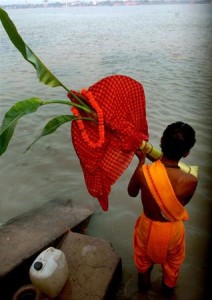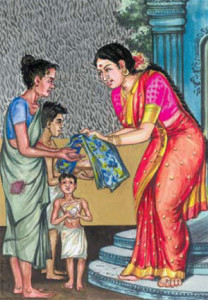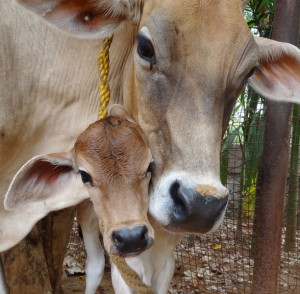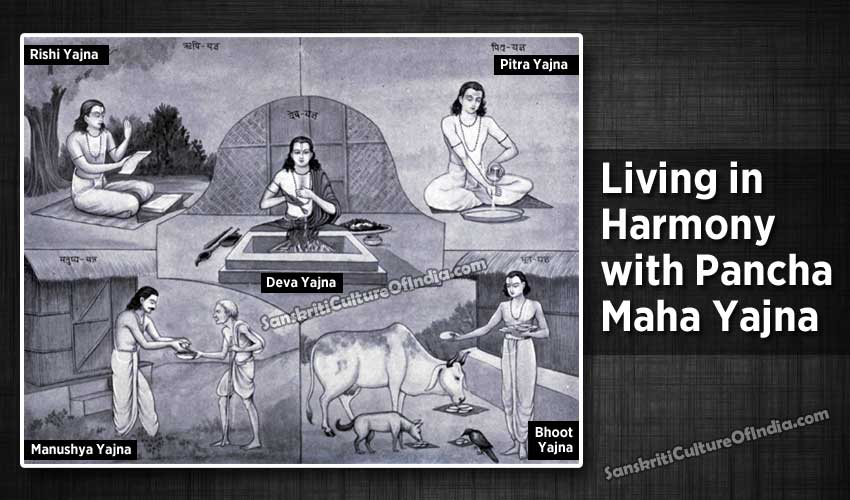Pancha Maha Yajnas are the five sacred duties to be performed as a way of life for living in harmony. To live in harmony with the world, we need to recognize our place within the larger scheme of things. We also need to be sensitive to ourselves, to others and to the environment.
One of the signs of emotional maturity is the ability to interact with others gracefully and to deal effectively with whatever situations we encounter. A person who is sensitive and mature does not take anything in Creation for granted. A mature person realizes the importance of the appropriate use of free will and makes a deliberate choice of doing what is to be done and does not give in to raga dwesa – likes and dislikes. Such a person is grateful to the Lord, Iswara for all that he has been given in life and expresses appreciation by performing the Pancha Maha Yajnas.
The five sacred duties are:
- Deva yajna – to the Lord-Iswara;
- Pitr. Yajna – to the family and ancestors;
- Brahma Yajna – to our Vedic culture;
- Manushya Yajna – to our fellow human beings and
- Bhutha Yajna – to the Eco-system.
All the five duties are equally important and performing more of one yajna cannot compensate for the non-performance of the other duties.
Symbols
Deva Yajna: The Kalasam, signifies auspiciousness, abundance, fulfillment and wisdom. In the Kalasam, we invoke Iswara, the Creator the source of all forms of life in the universe.
Pitr Yajna: The banana tree and its offshoot that comes up by itself, signifies the continuity of a lineage. It symbolises the transfer of family values and traditions to future generations for preserving them for posterity.
Brahma Yajna: The lamp represents the light of knowledge. Knowledge dispels the darkness of ignorance.
Manushya Yajna: The couple represents mankind and captures the spirit of accommodating people with compassion, sharing and understanding.
Bhutha Yajna: The cow and her calf symbolise the relationship between Mother Earth and her inhabitants. She responds with love and nourishes all living forms as long as we take and use her bounties with care and diligence.
Deva Yajna:
Ishaavaasyam Idam Sarvam
All that is here is Iswara

Deva Yajna is cultivating devotion with an understanding that all creation is a manifestation of Iswara and expressing our gratitude for all that is given to us. It is offering daily worship to the Gods in recognition of their presence as the various laws and functions that govern the universe.
Preserving temple culture is an important aspect of Deva Yajna. Like scriptures, the ancient temples of India are cornerstones of our rich Vedic heritage. Vedic culture has been nurtured in these temples for thousands of years.Worship of Iswara can be in any form: Yaga: a ritualistic sacrifice; Puja: ritualistic worship; Veda parayana chanting of vedic hymns; Japa: repetition of a meaningful chant, connecting us to Iswara; Dhyana: meditation, a mental activity where Iswara is the object of meditation; Namasankirtan: repetition of the name of Iswara; Yatra: pilgrimages or visits to temples; Kainkaryam: rendering voluntary services to temples with time, energy and resources.
As all creation is non-separate from Iswara, the Pancha- Mahabhutas, the five great elements that comprise all creation, are worshiped as Iswara. In the Vedic vision, Iswara is both the intelligent and material cause of creation. From the standpoint of the created universe, Iswara is conceived as having a threefold form corresponding to three simultaneous functions: creation, sustenance and destruction. Trimurthis are personified as Brahma, Vishnu and Rudra respectively, representing the intelligent aspect of each of these functions. Their respective consorts, Saraswathi, Lakshmi and Parvathi, represent the material aspect of each function.
Iswara is also worshipped in the form of various deities as representative of the different laws and functions. Some of the deities in our tradition include Ganesha, Rama, Krishna, Durga and Dakshinamurthi among many others. When every form is a manifestation of Iswara, we can invoke Iswara in any particular form and worship that Iswara with flowers and rituals. This unique and personalized form of worship is a beautiful concept.
A mind graced by devotion sees Iswara as the giver of all results of actions, the karma phala-data. We are blessed with free will to choose the actions. The universal laws that are non-separate from Iswara, produce the results of action. As results come from Iswara, there never is a wrong result or a result that one does not accept. Graceful acceptance of whatever comes to us from Iswara, is Iswara prasada buddhi. The graceful acceptance of all results brings sameness of mind, sama-cittatvam, in the face of desirable and undesirable results. This kind of devotion frees us from any kind of reaction. Objective and serene, a mind such as this is ready to discover the fact of one’s non-separateness from Iswara and creation.
Pitr Yajna:
Matrdevo bhava, Pitr. devo bhava
May your mother be a God to you, may your father be a God to you
 Pitr Yajna is the reverential bonding with parents, grandparents, ancestors, the entire parampara of forefathers and the fostering of family values for the unity and wellbeing of the family. This Yajna is caring for our parents and elders and performing rituals for our ancestors. It also involves upholding certain values and traditions handed down to us by our ancestors and passing these on to our children and future generations.
Pitr Yajna is the reverential bonding with parents, grandparents, ancestors, the entire parampara of forefathers and the fostering of family values for the unity and wellbeing of the family. This Yajna is caring for our parents and elders and performing rituals for our ancestors. It also involves upholding certain values and traditions handed down to us by our ancestors and passing these on to our children and future generations.
Caring for parents is an important aspect of family life. At some stage in our lives, we find ourselves becoming the link between two generations. Parenting becomes a full time responsibility and at the same time, our relationship with our parents undergoes significant changes. We need to balance both roles and be more available to them in order to provide economic, emotional and physical support.
In the Vedic culture, our self-identity is not looked at solely from an individual standpoint but includes the family and cultural background as well. This provides consistency in terms of values, philosophy, life-style and customs. Our self-worth includes respect for our family and culture.
Within the Indian family unit, relationships between people are highly interdependent. The individual is considered independent and yet an essential and integral part of a larger family unit where the well-being of one member lies in the well-being of all. A certain amount of voluntary sacrifice is to understand and accept this.
The family dharma, kula-dharma is handed down from one generation to the next. Dharma – what is to be done and what is not to be done, runs in the family and it will be destroyed if the family structure is not respected. Vedas talk of Vriddha Vyavahara, how we emulate elders in the family in social and individual situations, especially conflicting ones. Our elders become our role models. Therefore, maintaining kula- dharma is required for harmonious living.
We must show gratitude to our ancestors for our birth and family heritage. So, we should mentally invoke our ancestors and thank them through daily prayers. Besides daily prayers, the scriptures also prescribe certain compulsory ceremonies like Shraddham that must be performed on special days.
We begin any occasion or celebration in the family by offering prayers to our ancestors as a way of thanksgiving and to seek their blessings for our prosperity and that of our progeny. This reinforces our place and survival in the entire kula or clan.
Brahma Yajna:
Acharya devo bhava
May your teacher be God to you
 Brahma Yajna is our reverential contribution to preserve Vedic culture through worship of the scriptures, the rishis and teachers of the Vedic vision who have contributed to the spiritual culture of our land.
Brahma Yajna is our reverential contribution to preserve Vedic culture through worship of the scriptures, the rishis and teachers of the Vedic vision who have contributed to the spiritual culture of our land.
Brahma Yajna is the effort to study and understand the scriptures under the guidance of a teacher trained in the sampradaya tradition. Supporting Veda patashalas, Vedanta teaching institutions and ashrams are important aspects of this Yajna. Since our primary scriptures are in Sanskrit, it is also important to preserve the Sanskrit language.
The Vedas are our primary scriptures. There are four Vedas —Rig Veda, Yajur Veda, Sama Veda and Atharvana Veda. The Vedas were revealed by the Lord to the seers, rishis, who were capable of receiving and handing over the knowledge to posterity for the benefit of humanity. The Vedas, being in the form of Shabda or sound waves, have been preserved through the ages in the form of a highly sophisticated oral tradtion.
The Vedas are divided into two sections. The first section, Veda-purva or the karma-kanda deals with dharma – ethics, artha – security, Kama – pleasure. All the actions described in this section are for the fulfillment of the first three life. The last section of the Vedas, Vedantha or the jnanakanda deals with a single desire, moksha-freedom from any sense of limitation. The fulfillment of this desire is not through actions, but through knowledge. The gaining of this knowledge is to achieve the ultimate end, moksha.
The Vedic vision says that all that is here is Iswara. To help a person discover this, Vedic culture provides a meaningful way of life. A life in conformity with the universal values becomes an important part of living. The emotional maturity of a person living such a way of life will happen naturally, as one becomes sensitive to oneself and everything else in the world.
Vedic culture has survived thousands of centuries of change because of its inherent self-sustaining strength. It has always been flexible and adaptable and at the same time, has its basis in realities fundamental to a human being.
The essence of the Vedic culture is its teaching tradition based on the Vedas. It addresses the fundamental problems that are relevant to the life of every human being such as be free from being a wanting person and our need to be free from sorrow and mortality. The teaching tradition helps us discover our essential nature as being free from limitations. This knowledge enables us to live in harmony with all beings and our environment. This is the strength of the Vedic culture.
The teaching tradition of the Vedas has been kept alive through a teacher -student lineage known as guru-sishya parampara. This lineage can only originate from a teacher who has all knowledge and has been traced to the lord himself. The lord in his role as the first teacher is given the name Dakshinamurthi. Brahmarishi Viswamitra,VedaVyasa, Adi Sankara are great gurus.
If sanatana dharma is alive and in practice today, it is because of the contributions made by venerable rishis, later acharyas and our teachers-Pujyasri Swami Dayananda Saraswati and Pujyasri Swami Paramarthananda Saraswati.
Manushya Yajna:
Nara Seva Narayana Seva
Service to humanity is service to God
 Manushya Yajna is service to humanity with the attitude of serving the Lord. Seeing divinity in everyone and serving people is the highest form of service. In such a form of service, there is only gratitude towards the person for giving us an opportunity to serve.
Manushya Yajna is service to humanity with the attitude of serving the Lord. Seeing divinity in everyone and serving people is the highest form of service. In such a form of service, there is only gratitude towards the person for giving us an opportunity to serve.
Service is being sensitive to the needs of fellow human beings, sharing and caring for them. As individuals, corporate entities or as collective bodies, we care and express that we care. We can share our knowledge, resources, time and also pray for others. Atithi seva – hospitality to a guest and purta karma – actions done for the benefit of society are significant components of Manushya Yajna. Purta karma includes constructing water reservoirs, tanks and lakes, cleaning rivers, providing infrastructure facilities, establishing and supporting educational institutions, and health care that can be of service to humanity.
By sharing, we grow from being only a consumer to a contributor. Living begins when we contribute something that will bring about more joy, happiness, light and freedom. Merely getting on is not really ‘living’. To live is to be a positive contributor. To grow from a consumer into a contributor, we must cultivate compassion. This value evokes the largeness of the heart, love, giving, gentleness, understanding and respect for all humanity.
In order to cultivate the value of Daana, giving, there are many occasions and situations that are considered auspicious in our culture. Many occasions like birth, wedding, sixtieth and eightieth birthdays, death, eclipses and festivals are intrinsically associated with daana or giving. There are many forms of daana like Anna daana, Vidya daana, Dhana restricted to time or place. Even though the above occasions are considered to be auspicious, we can give at any time at any place. Daana is not just the act of giving; it is also the attitude with which we give.
Daana is a mark of growth. One of the obstacles of self growth is the inability to give even when there is a situation that requires us to give. To grow into an adequate and secure person and to help others to grow is our culture, and this growth does not happen without our initiative. Our way of life should make us grow into the fullness that we are capable of.
Corporates and collective bodies have a larger role to play in Manushya yajna. Growth has to be inclusive and beneficial to society. We have to contribute proportionately to our capacity. To do this, we need to understand the objective value of money and its role in our lives. Money is a means for accomplishing various ends, but it can neither fulfil our need for emotional security, nor can it compensate for an inadequacy. A true sense of security however is born of an appreciation of inner fullness, not of external wealth. When we understand the objective value of money and recognize its limitations as well, we can handle money in a mature way and share it with others graciously.
Our success is because we are in the right place, at the right time. It is because of grace and we have to be grateful for that. When we are in a position of power, coming out of that grace of being at the right place, at the right time, then that power has to be used for caring and giving.
Bhutha Yajna:
Ahimsa paramo dharmah
Non-injury is the foremost value
 Bhutha Yajna is appreciating all creation as Iswara, preserving and living in conformity with the laws of Nature, worshipping animals, plants, trees, forests and all other forms of life. Worship is considering Nature and all forms of life as sacred and showing kindness and compassion to them. Both recognition and sensitivity are involved; by recognizing cosmic forces, we do not take anything for granted. Sensitivity to environment and understanding of ecology are vital for preservation of life.
Bhutha Yajna is appreciating all creation as Iswara, preserving and living in conformity with the laws of Nature, worshipping animals, plants, trees, forests and all other forms of life. Worship is considering Nature and all forms of life as sacred and showing kindness and compassion to them. Both recognition and sensitivity are involved; by recognizing cosmic forces, we do not take anything for granted. Sensitivity to environment and understanding of ecology are vital for preservation of life.
Our reverential contribution to Bhutha Yajna involves working to improve ecological balance in all respects, such as feeding and caring for animals, planting trees and sustaining water bodies and preserving the environment.
Reverence to Nature is steeped in our culture. We revere trees, plants, animals, rivers and Mother Earth. We worship the Tulsi plant as a manifestation of Goddess Lakshmi. associated with the sacred place and located behind the sanctum sanctorum. For instance, the Aswatha, Pipal, Banyan and Neem are considered sacred and are worshiped.
Our deities are associated with animals and birds as vahanas or vehicles to encourage us to develop respect and kindness towards them We worship different deities, along with the vahanas. Feeding domestic animals and birds is part of the daily routine in most households.
All these different forms of worship should be understood with the spirit and attitude of nurturing. Ahimsa or nonviolence is a dharma or universal value that is a commitment to a life-style of least disturbance. In a relative world, absolute ahimsa is not possible and therefore has to be understood and practiced with its limitations.
In the vedic culture, Nature is never looked at as a commodity. All natural resources are there for the use of all living beings. We have to use them with care and caution and not abuse or plunder them. Tampering with the delicate balance is short-sighted. All environmental issues are due to not being in harmony with nature. When the ecology is disturbed then all economic activity and prosperity will be affected.
Sustainable development and resource management entails using natural resources in ways that are beneficial to human maintaining their availability to support biological diversity and continuing human use in the future.
On a simple level, environmental awareness is understanding the interconnection of all things and living in a manner that respects the ecological balance. At a deeper level, environmental awareness is an appreciation of Iswara, with reference to creation. When we are in harmony with the natural laws which are consistent, unbiased and non-separate from Iswara, we remain in harmony with ourselves.
When we understand the importance of each of the five sacred yajnas, it helps us to perform all our duties with the right attitude. We are able to perform the various rituals with a true understanding of the spirit behind the forms. The inner harmony and rhythm born out of performing the five sacred duties helps us to pursue our goals successfully in alignment with Dharma with least efforts. We thus,become blessed with all forms of Lakshmi in our lives.
~ Kalavardhini Study Group











